Tony Gonsolin’s 16-1 Record Ain’t What It Used To Be
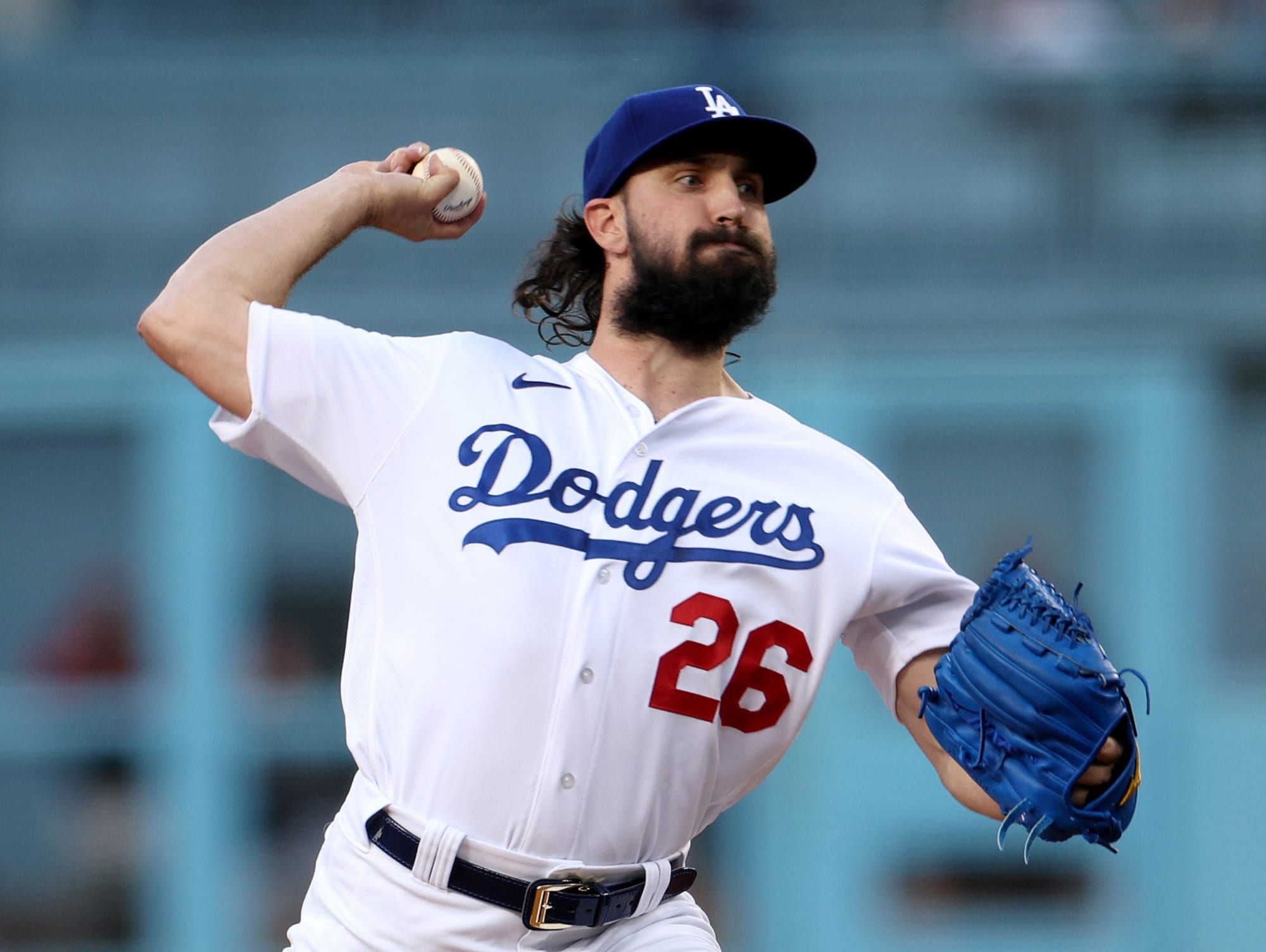
There are 17 National League pitchers listed with NL Cy Young Award Odds at Vegas Insider. Tony Gonsolin has a record of 16-1 and a 2.10 ERA. He’s ranked fifth on the list, at +4000. Gonsolin’s teammate on the Dodgers, Tyler Anderson, is 15-3 with a 2.62 ERA. He’s tied for 14th on the list. Tied for 12th is Atlanta’s Kyle Wright, who leads the NL in wins at 18-5 and has a 3.18 ERA. Meanwhile, Aaron Nola (9-11, 3.31 ERA), has better odds than Tyler Anderson and Kyle Wright and also Yu Darvish (14-7, 3.16) and Zack Wheeler (11-7, 3.07) despite Nola having fewer wins, a losing record, and a higher ERA than all four.
2022 NL CY YOUNG ODDS (as of September 15):
- Sandy Alcantara -225
- Julio Urias +550
- Zac Gallen +650
- Max Fried +650
- Tony Gonsolin +4000
- Spencer Strider +8000
- Corbin Burnes +12500
- Max Scherzer +12500
- Edwin Diaz +15000
- Carlos Rodon +15000
- Aaron Nola +15000
- Zack Wheeler +25000
- Kyle Wright +25000
- Tyler Anderson +50000
- Yu Darvish +50000
- Jacob deGrom +50000
- Joe Musgrove +50000
This is the world we live in now, where a pitcher’s win-loss record and ERA are not as important as their innings pitched, strikeouts, and—choose one or more—FIP/xFIP/SIERA. And there are good reasons for it. Nowadays, we are more aware of the shortcomings of a pitcher’s win-loss record and how team-dependent, lineup-dependent, and luck-dependent it can be. We also value innings and strikeouts and the alternatives to ERA—FIP/xFIP/SIERA—which were created to isolate what a pitcher has the most control over, namely, strikeouts, walks, and home runs allowed.
While I embrace the modern analysis of the game, as a longtime baseball fan I have some nostalgia for the impressive win-loss records of great pitchers in the past. I was too young to experience Ron Guidry going 25-3 in 1978, but I read about it later and loved how it looked in the Baseball Encyclopedia. I was at the right age to be in awe of Dwight Gooden going 24-4 and Orel Hershiser finishing 19-3 in 1985 and Roger Clemens matching Gooden’s 24-4 record in 1986.
I was in the crowd at the Kingdome in 1995 for some incredible starts when Randy Johnson went 18-2, with that 18th victory coming in a one-game playoff against the Angels to put the Mariners in the postseason for the first time in franchise history. Greg Maddux was 19-2 in 1995 and 19-4 two years later (when Johnson was 20-4). I remember Pedro Martinez going 23-4 in 1999, which looked like his peak season until he was arguably even better in 2000 despite a worse win-loss record (18-6).
This season, Tony Gonsolin and Tyler Anderson have a combined record of 31-4 because they’ve pitched well and because they’ve pitched for the best team in baseball. The Dodgers’ .690 winning percentage through September 15 equates to about 112 wins in a 162-game season. It’s good to pitch for the Dodgers. So good, in fact, that we can be confident that Gonsolin and Anderson would NOT be a combined 31-4 if they pitched for the Nationals, for example.
Gonsolin’s 16-1 record, in particular, is historically good. He started the year 11-0, lost his first game on July 25, then won five straight. Unfortunately, he last pitched on August 23 because he was placed on the IL six days after running his record to 16-1. He recently threw a bullpen session as he attempts to make his way back to the Dodgers while they gear up for the postseason.
In a different era, Gonsolin’s 16-1 record would be much bigger news. In baseball history, the only other pitchers with at least 16 wins and a single loss are Roy Face, who was 18-1 for the 1959 Pittsburgh Pirates, and Connie Rector, who was 18-1 for the 1929 New York Lincoln Giants of the American Negro league, according to Baseball-Reference.com.
Face went 18-1 while pitching exclusively in relief. According to this detailed breakdown at SABR, he earned nine of his 18 wins when he came into a tied game, six of which were in extra-innings. He also earned four other extra-inning wins. As you’d expect during an 18-1 season for a team that went 78-76-1, there was some luck involved with Roy Face that season. In fact, four of his wins were of the “blown save and win” variety.
There’s no such game-by-game breakdown for Connie Rector, who has statistics listed for 13 seasons at Baseball-Reference, including that 18-1 season in 1929, when he was 37 years old. Despite only 13 seasons listed at B-Ref, this article claims his baseball career spanned at least 34 years. It also claims Rector actually went 20-3 for the 1929 Lincoln Giants based on year-end statistics from the Pittsburgh Courier, so it’s possible he doesn’t belong on this list. It may be just Roy Face and Tony Gonsolin in the 16-or-more-wins and no-more-than-one-loss club.
Gonsolin, despite his 16-1 record and 2.10 ERA, will not win the NL Cy Young Award this year. That trophy is most likely going to Sandy Alcantara, who is 12-8 with a 2.43 ERA. The biggest difference between the two is Alcantara’s 203 2/3 innings pitched versus 128 1/3 for Gonsolin.
In fact, Alcantara has pitched 20 more innings than the next pitcher on the list, Aaron Nola. Alcantara simply shows up every day, pitches deeper into games than the other NL pitchers, and has done a good job of keeping runs off the scoreboard. That’s why he’s the odds-on favorite to win the NL Cy Young despite being tied for eighth in wins.
The following chart shows the 17 contenders with some traditional statistics and their current odds to win the NL Cy Young Award. Category leaders are highlighted in gold for pitchers with enough innings to qualify for the ERA title (which means starters only, apologies to Edwin Diaz).
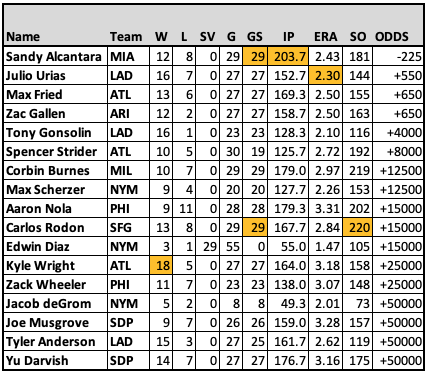
Alcantara has a big lead in innings pitched and a great ERA (second among qualified NL pitchers behind Julio Urias). He’s the favorite, with Urias, Fried, and Gallen his closest competitors on the betting market. MLBAM Senior Data Architect Tom Tango has his own Cy Young predictor, which has Alcantara in the lead, with Urias, Fried, and Gallen, along with Rodon and Burnes “dancing for 2nd.” Burnes (+12500) and Rodon (+15000) are further down the list at Vegas Insider than on Tango’s Cy Young predictor rankings.
This next chart is all about earned runs allowed and runs that, theoretically, are more the responsibility of the pitcher than the pitcher plus the defense. It shows each pitcher’s innings pitched, ERA, xERA, FIP, xFIP, SIERA, and WHIP. The average column is just that—the average of the runs allowed metrics. Carlos Rodon and Aaron Nola shine here, with Rodon leading qualifying NL starters in xERA, FIP, and the average of all five, while Nola leads in xFIP and SIERA. Zac Gallen leads qualifying NL pitchers in WHIP.
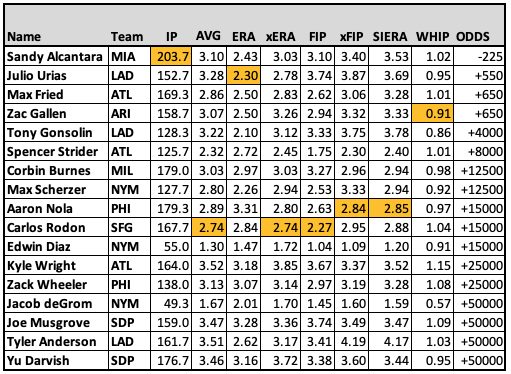
One of the most revealing metrics for pitchers is K-BB% because strikeouts and walks are the two things pitchers have the most control over. Among the top 12 qualifying NL starting pitchers in K-BB%, only Charlie Morton has an ERA higher than 3.50 (and his SIERA is 3.44). The following chart shows once again how good Carlos Rodon has been (league leader in K-BB% among qualifying pitchers). It also shows what good control Aaron Nola has had this year. Also, it should be noted that Jacob deGrom is better than every starting pitcher at everything, but hasn’t pitched enough this year to be in serious contention for the NL Cy Young Award.
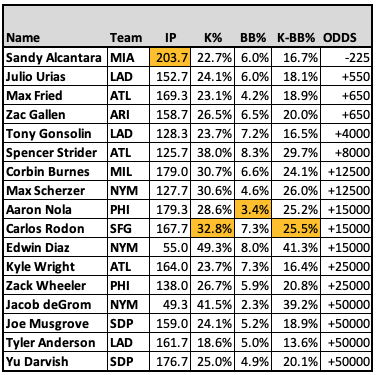
Finally, the chart below shows three different Wins Above Replacement metrics for these 17 pitchers. fWAR and RA9-WAR are from FanGraphs. fWAR uses Fielding Independent Pitching (FIP) as its core component, while RA9-WAR uses runs allowed per nine innings. bWAR (Baseball-Reference WAR) is more like FanGraphs’ RA9-WAR in that it also uses runs allowed.
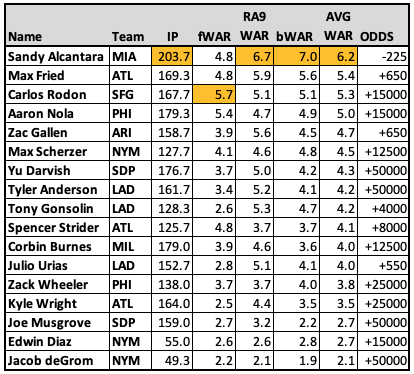
In the column second-from-the-right, I averaged the three different WARs. Using this combination, Sandy Alcantara is on top, followed by Max Fried, Carlos Rodon, and Aaron Nola. I’m not necessarily saying this is the best way to determine a pitcher’s value. It’s just one way. If you prefer fWAR, Carlos Rodon is your man, with Aaron Nola not too far behind him.
As for Tony Gonsolin, his comparatively few innings and less-than-stellar FIP, xFIP, and SIERA land him in the middle-of-the-pack among these pitchers, but that 16-1 record and 2.10 ERA look very cool on his FanGraphs and Baseball-Reference pages. If he comes back in time to get two more starts, he could equal Roy Face at 18-1 . . . and still not win the NL Cy Young Award.
















